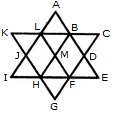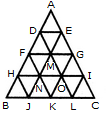Counting
Counting Parallelograms
Q1) Count the number of quadrilaterals in the given figure 1) 6 2) 7 3) 9 4) 11 Solution: The figure may be labelled as shown.  The quadrilaterals in the figure are ABCD, ABDE, ABDF, ABDH, CDHA, CDEA, CDFA, DEAG, DEFA, FAGD and AGDH. The number of quadrilaterals in the figure is 11. Read More: Questions on Counting number of RectanglesQ2) Count the number of parallelograms in the given figure 1) 12 2) 16 3) 18 4) 20 Solution: The figure may be labelled as shown.  The simplest parallelograms are ABFE, BCGF, CDHG, EFJI, FGKJ and GHLK. These are 6 in number. The parallelograms composed of two components each are ACGE, BDHF, EGKI, FHLJ, ABJI, BCKJ and CDLK. Thus, there are 7 such parallelograms. The parallelograms composed of three components each are ADHE and EHLI i.e. 2 in number. The parallelograms composed of four components each are ACKI and BDLJ i.e. 2 in number. There is only one parallelogram composed of six components, namely ADLI. Thus, there are 6 + 7 + 2 + 2 + 1 = 18 parallelograms in the figure. Read More: Questions on Counting number of SquaresDownload: Practice Questions on Counting Geometrical FiguresQ3) Count the number of triangles and parallelograms in the given figure  1) 21, 17 2) 19, 13 3) 21, 15 4) 19, 17 Solution: The figure may be labelled as shown.  Triangles: The simplest triangles are KJN, KJO, CNB, OEF, JIL, JIM, BLA and MFG i.e. 8 in number. The triangles composed of two components each are CDJ, EDJ, NKO, JLM, JAH and JGH i.e. 6 in number. The triangles composed of three components each are BKI, FKI, CJA and EJG i.e. 4 in number. The triangles composed of four components each are CDE and AJG i.e. 2 in number. The only triangle composed of six components is BKF. Thus, there are 8 + 6 + 4 + 2 + 1 = 21 triangles in the given figure. Parallelograms: The simplest parallelograms are NJLB and JOFM i.e. 2 in number. The parallelograms composed of two components each are CDKB, DEFK, BIHA and IFGH i.e.4 in number. The parallelograms composed of three components each are BKJA, KFGJ, CJIB and JEFI i.e.4 in number. There is only one parallelogram i.e. BFGA composed of four components. The parallelograms composed of five components each are CDJA, DEGJ, CJHA and JEGH i.e.4 in number. The only parallelogram composed of six components is CEFB. The only parallelogram composed of ten components is CEGA. Thus, there are 2 + 4 + 4 + 1 + 4+ 1 + 1 = 17 parallelograms in the given figure. (Here note that the squares and rectangles are also counted amongst the parallelograms). Read More: Questions on Counting number of TrianglesRead More: Shortcuts for Geometrical PatternsQ4) Count the number of parallelograms in the given figure 1) 8 2) 11 3) 12 4) 15 Solution: The figure may be labelled as shown.  The simplest parallelograms are LMHJ and BDFM i.e. 2 in number. The parallelograms composed of two components each are ABML and MFGH i.e. 2 in number. The parallelograms composed of three components each are LBHI, LBEF, BDGH, DFLA, BCFH, KLFH, A6HJ and LFGJ i.e. 8 in number. The parallelograms composed of six components each are LCFI, KBEH and ADGJ i.e. 3 in number. Total number of parallelograms in the figure = 2 + 2 + 8 + 3 = 15. Q5) Count the number of parallelograms in the given figure  1) 39 2) 41 3) 45 4) 47 Solution: The figure may be labelled as shown.  The parallelograms composed of two components each are ADME, DFNM, EMOG, FHJN, MNKO, GOLI, HBJN, NJKO, OKLI, FHNM, MNOG, DFME, HJKN, NKLO, OLCI, FNOM, MOIG and DMGE. i.e. 18 in number. The parallelograms composed of four components each are HOKB, NILJ, FGOH, HOLJ, NICK, FGIN, FMJB, DENH, MGKJ, MGCL, DEIO, FMLK, AENF, AGOD, DMJH, DOKF, EILM and EGKN i.e. 18 in number. The parallelograms composed of six components each are AEJH, DAIL, DECL, DEJB, HILB and HICJ i.e. 6 in number. The parallelograms composed of eight components each are FGKB, FGCK and AGKF i.e. 3 in number. Total number of parallelograms in the figure = 18 + 18 + 6 + 3 = 45. Q6) Count the number of parallelograms in the given figure  1) 18 2) 21 3) 22 4) 23 Solution: The figure may be labelled as shown.  The simplest parallelograms are EMLA and NIDJ i.e. 2 in number. The parallelograms composed of two components each are BFMG, CGNH, GMKN, FGME, GHNM, MNKL, FGNM, GHIN and MNJK i.e. 9 in number. The parallelograms composed of three components each are FGLA, ENKA, GHDJ and MIDK ie. 4 in number. The parallelograms composed of four components each are FGJK, GHKL, FBNK, CHKM, EFHN and MFHI i.e. 6 in number. The parallelograms composed of seven components each are FHKA and FHDK i.e. 2 in number. Total number of parallelograms in the figure = 2 + 9 + 4 + 6 + 2 = 23. |